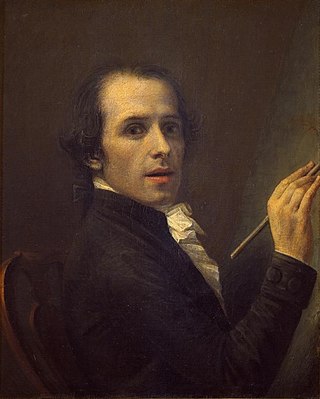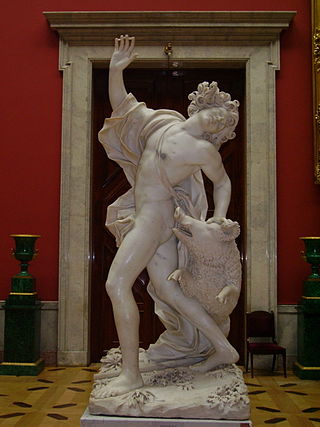Related Research Articles

Antonio Canova was an Italian Neoclassical sculptor, famous for his marble sculptures. Often regarded as the greatest of the Neoclassical artists, his sculpture was inspired by the Baroque and the classical revival, and has been characterised as having avoided the melodramatics of the former, and the cold artificiality of the latter.

Antonio Allegri da Correggio, usually known as just Correggio, was the foremost painter of the Parma school of the High Italian Renaissance, who was responsible for some of the most vigorous and sensuous works of the sixteenth century. In his use of dynamic composition, illusionistic perspective and dramatic foreshortening, Correggio prefigured the Baroque art of the seventeenth century and the Rococo art of the eighteenth century. He is considered a master of chiaroscuro.

Annibale Carracci was an Italian painter and instructor, active in Bologna and later in Rome. Along with his brother and cousin, Annibale was one of the progenitors, if not founders of a leading strand of the Baroque style, borrowing from styles from both north and south of their native city, and aspiring for a return to classical monumentality, but adding a more vital dynamism. Painters working under Annibale at the gallery of the Palazzo Farnese would be highly influential in Roman painting for decades.

Andrea Mantegna was an Italian painter, a student of Roman archeology, and son-in-law of Jacopo Bellini.

Mino da Fiesole, also known as Mino di Giovanni, was an Italian Renaissance sculptor from Poppi, Tuscany. He is noted for his portrait busts.

Arnolfo di Cambio was an Italian architect and sculptor of the Duecento, who began as a lead assistant to Nicola Pisano. He is documented as being capomaestro or Head of Works for Florence Cathedral in 1300, and designed the sixth city wall around Florence (1284–1333).

Lorenzo Lotto was an Italian painter, draughtsman, and illustrator, traditionally placed in the Venetian school, though much of his career was spent in other north Italian cities. He painted mainly altarpieces, religious subjects and portraits. He was active during the High Renaissance and the first half of the Mannerist period, but his work maintained a generally similar High Renaissance style throughout his career, although his nervous and eccentric posings and distortions represented a transitional stage to the Florentine and Roman Mannerists.

Pierre-Jean David was a French sculptor, medalist and active freemason. He adopted the name David d'Angers, following his entry into the studio of the painter Jacques-Louis David in 1809 as a way of both expressing his patrimony and distinguishing himself from the master painter.

Albert-Ernest Carrier-Belleuse was a French sculptor. He was one of the founding members of the Société Nationale des Beaux-Arts, and was made an officer of the Legion of Honour.
The decade of the 1460s in art involved some significant events.

Giovanni Dupré was an Italian sculptor, of distant French stock long settled in Tuscany, who developed a reputation second only to that of his contemporary Lorenzo Bartolini.

Giuseppe Mazzuoli was an Italian sculptor working in Rome in the Bernini-derived Baroque style. He produced many highly accomplished sculptures of up to monumental scale but was never a leading figure in the Roman art world.

Giovanni Maria Mosca or Giovanni Padovano was an Italian Renaissance sculptor and medallist, active between 1515 and 1573, initially in the Veneto and after 1529 in Poland, where his first name was rendered Jan.
References
- Database downloaded in April 2014 from the Web Gallery of Art website
- commons:Category:Web Gallery of Art
- Netherlands Institute for Art History